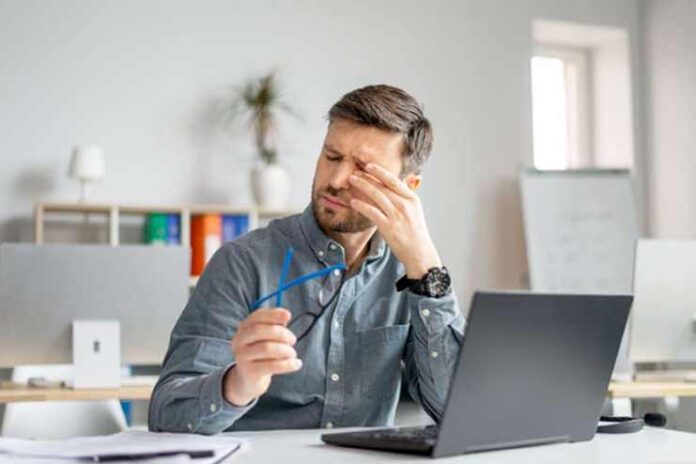Affiliate Disclaimer
Some links in this article are affiliate links. We may earn a small commission if you make a purchase through these links, at no extra cost to you. We only recommend products we find useful to our readersIf you work in an office, you spend many hours gazing at a computer screen each day. Even though this kind of technology is beneficial, it might cause digital eye strain. Constant screen time on computers, laptops, and smartphones seriously taxes the eyes. Research indicates that more than half of office workers suffer from symptoms known as computer vision syndrome, which includes headaches, dry eyes, and impaired vision.
Related Article: Combat Digital Eye Strain: 7 Blue Light Blocking Glasses for Screen Time Relief
1. Understanding Digital Eye Strain
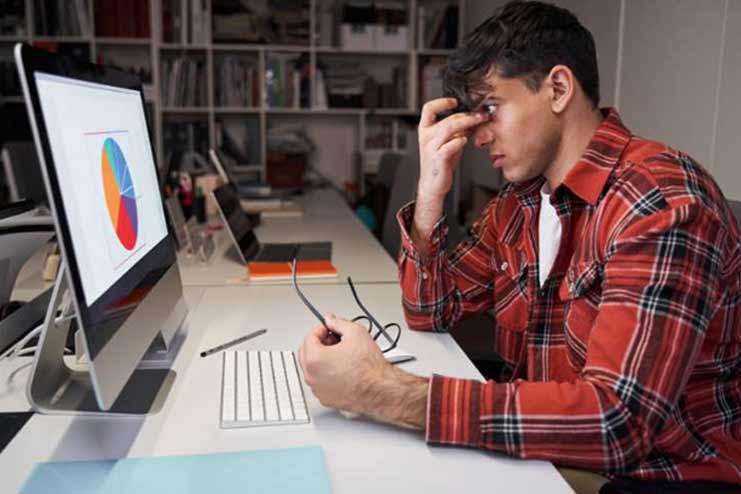
The term “digital eye strain” describes a group of vision issues brought on by prolonged screen use. In the current digital era, it has become nearly hard to escape screens. Headaches, blurred vision, dry or irritated eyes, and trouble focusing on the computer are common symptoms of digital eye strain. Poor posture when using a computer can also cause pain in the neck and shoulders for certain people.
Long-term computer use causes eye strain in several ways. A contributing aspect is that staring at a screen all day strains your eyes. In actuality, eye muscles must physically interact with your lens for your eye to focus and your gadget to display effectively. Your muscles will eventually become tired from this, resulting in eye tiredness. Additionally, gazing at a computer screen might cause your blink rate to drop by as much as 50%.
Also, read: 11 Best Anti Fog Glasses Against Your Eye Protection
2. Adjusting Your Workspace for Eye Comfort

Reducing digital eyestrain and increasing eye comfort requires an ergonomic workstation. Ergonomics is the science of creating and organizing a workspace to guarantee comfort, effectiveness, and safety. Proper ergonomics can greatly aid in maintaining good vision and minimizing digital eye strain. You can protect your eyes from needless strain and discomfort by setting up your workspace to reduce glare, align the screen at the proper distance and angle, and encourage a comfortable viewing position.
The distance between your eyes and your screen should be an arm’s length (about 20 to 24 inches), with the top of the display at or slightly below eye level. This minimizes excessive eye movement and guarantees a natural viewing angle. Proper screen distance also helps lessen headaches and hazy vision with extended screen time.
Another critical component is lighting. Proper illumination is required to maintain visual comfort and avoid eye strain. Make sure there is adequate lighting in your office, but stay away from direct or overly bright light sources, as these can produce glare. Adjusting the monitor’s brightness to the surrounding environment is also essential. It would help to balance screen brightness and darkness to prevent eye strain.
When you sit in a chair, your knees should be at 90-degree angle, and your feet should be flat on the ground. Maintaining good posture helps to ease shoulder and neck tension, which can lead to discomfort when using a screen.
Also, read: 10 Best Eye Masks To Soothe Dry Eyes
3. The 20-20-20 Rule

The 20-20-20 rule is a straightforward and compelling tactic to lessen eye strain brought on by extended screen use. Take a 20-second break every 20 minutes and fix your attention on anything at least 20 feet away. This exercise helps prevent digital eye strain by gently relaxing your eye muscles. You can also stretch and unwind in other body parts during this period.
In addition, you ought to try to step away from your computer or other electronic device for fifteen minutes every two hours. During these periods, take a brief walk or get up to stretch to release physical strain in your back, shoulders, and neck. Taking a stroll outside in the daylight can be a wonderful way to unwind and relieve eye strain.
Practicing the 20-20-20 rule also increases productivity by lowering visual discomfort-related distractions. Taking regular breaks that support eye health makes it simpler to stay focused and attentive throughout the job.
4. Blue Light Filters and Screen Settings
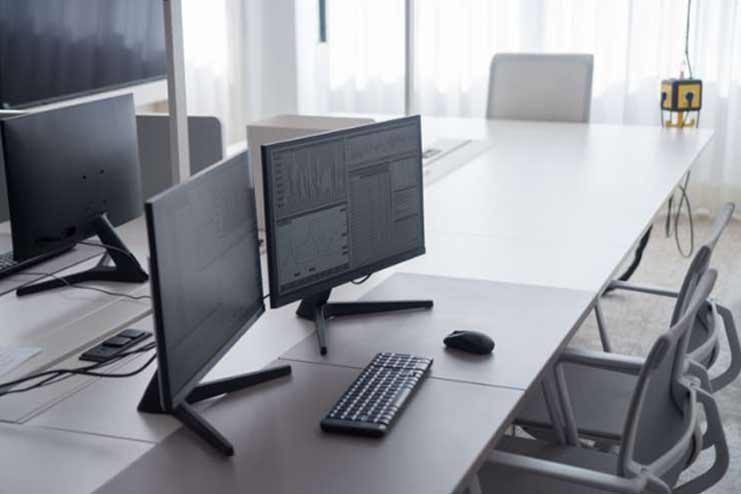
Blue light, released by digital screens, is one of the leading causes of digital eye strain. Long-term exposure raises the chance of developing long-term eye health problems and can interfere with sleep cycles. Computer screens may exacerbate eye strain. Use anti-blue light screen protectors on your phone and laptop, or wear blue-blocking glasses. By lowering the amount of blue light screens generate, these filters help lessen eye strain.
Furthermore, most PCs, cellphones, and tablets have screen options like “Night Mode” or “Blue Light Mode” that automatically change the display’s color temperature to lessen blue light in the evening. You may avoid squinting by adjusting the screen’s brightness, contrast, and font size to find that sweet spot. Additionally, using dim screens in bright situations or dark rooms might lead to needless strain. Blue light’s harmful effects on your eyes can be mitigated by including these choices in your daily digital routine.
Also, read: Top 3 UV-Blocking Sunglasses: Essential Eye Protection for Sun Exposure
5. Regular Eye Care and Blink Exercises
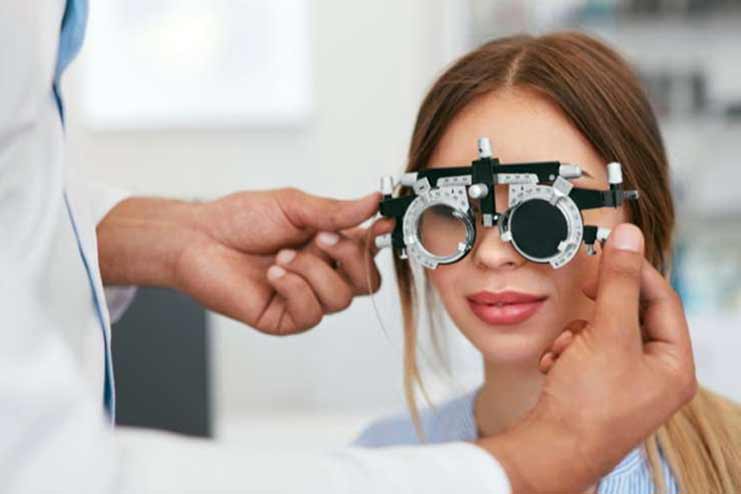
Maintaining general eye health requires prioritizing routine eye exams, especially for people who spend a lot of time in front of screens. They’re not simply a formality; they’re essential for monitoring the condition of your eyes and identifying any visual problems early on. Problems can occasionally be more than just digital eye strain. Prolonged symptoms of eye strain that do not go away may indicate the presence of dry eye conditions, myopia, presbyopia, or other problems. Frequent examinations assist in avoiding long-term issues by ensuring that your prescription is current and your eyes are in good health.
Blinking exercises and professional treatment might help lessen eye fatigue in addition to eye workouts. Blinking often is essential to prevent dry eyes and maintain moisture in your eyes. People tend to blink less when using displays, which can irritate them. Remember to blink every few seconds to maintain lubrication in your eyes.
To lessen strain, include easy eye workouts in your everyday routine. Easy eye exercises like moving your eyes in circles or focusing on far-off objects can help relax the eye muscles, enhancing focus and lessening tension. When paired with regular examinations, these methods can significantly improve eye health and reduce the discomfort that comes with extended screen use.
Also, read: 7 Lavender Eye Pillows: Natural Headache and Eye Relief
6. Applications to Aid with Eye Care
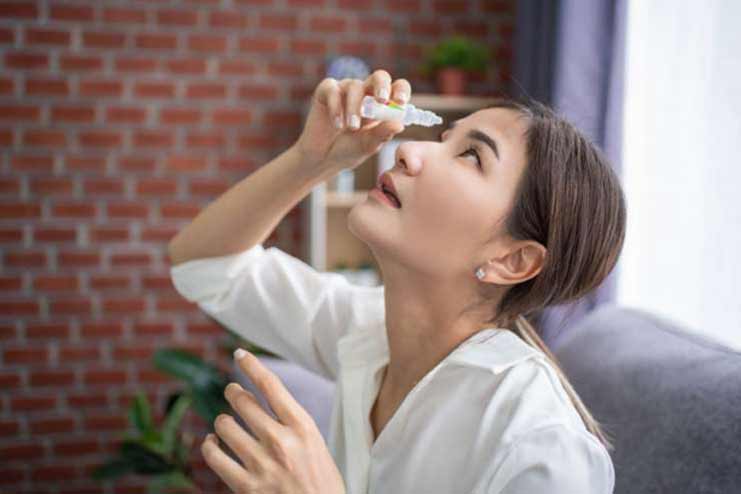
Apps that relieve eye strain are becoming increasingly common in today’s digital world to assist office workers in managing digital eyestrain. These cutting-edge technological solutions, which include features like screen-dimming, eye-care timers, and break reminders, ensure that your eyes get the rest they need throughout extended periods of screen usage.
One well-liked program is f.lux, which lessens the harshness of blue light in the evening by automatically adjusting the brightness and the color temperature of your screen based on time of day. It reduces eye strain and enhances the quality of sleep.
Another useful app called Eyeleo encourages regular pauses and offers eye exercises to help with focus and relaxation. It is an easy method for ensuring proper eye care when using a screen for extended periods of time.
Conclusion
Your eyes are incredibly precious and should be treated with excellent care, particularly at work when constantly strained. In an atmosphere where screens are used extensively, preventing digital eyestrain is essential to preserving long-term eye health.
You may significantly lessen the strain on your eyes by adjusting your workspace, applying the 20-20-20 rule, adding blue light filters, and taking frequent care of your eyes.
References
- https://www.aao.org/eye-health/tips-prevention/computer-usage
- https://ophthalmology.wustl.edu/digital-eye-strain-tips-for-a-healthier-screen-time
- https://ghpnews.digital/a-workplace-guide-to-eye-health-how-to-avoid-long-term-digital-eye-strain-in-employees
- https://www.carecredit.com/well-u/health-wellness/tips-for-preventing-digital-eye-strain
- https://www.aao.org/newsroom/news-releases/detail/ergonomics-eyes-tips-avoid-computer-eye-strai
- https://mikomaxsmartoffice.com/en/how-to-prevent-eye-fatigue-at-the-office-here-are-some-useful-tips
- https://www.uoosd.com/workplace-eye-health
- https://fentonfamilyeyecare.com/ergonomics-for-healthy-vision-tips-for-setting-up-your-workspace-to-prevent-eye-strain
- https://www.hp.com/in-en/shop/tech-takes/post/reducing-blue-light-on-your-pc-screen
- https://www.viewsonic.com/library/business/blue-light-filter-eye-strain
- https://www.eyelink.com/blinking-exercises
- https://www.medicalnewstoday.com/articles/blinking-exercises-for-dry-eyes
- https://www.healthline.com/health/dry-eye/blinking-exercises-for-dry-eye
- https://www.overlakeeyecare.com/blinking-exercises
- https://justgetflux.com
- http://eyeleo.com














